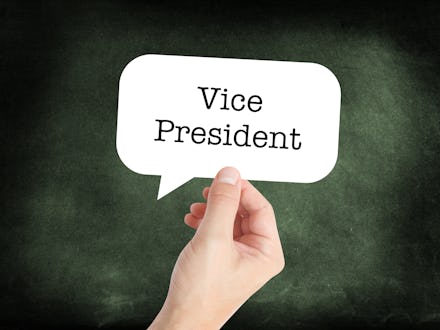This New Campaign Will Let You Vote for Vice President — With Your Wallet

Imagine an America in which the people — not presidential candidates — chose the vice president.
As Election 2016 goes from a melee to a showdown between Hillary Clinton and Donald Trump, there's a new way for people to make their voices heard in the veepstakes.
Read more: Listen to Episode 3 of 'Special Relationship,' a Podcast From 'Mic' and The 'Economist'
Crowdpac's new VP Draft campaign, previewed exclusively to Mic ahead of its launch Thursday, lets donors pledge their money to presidential nominees conditionally: The charge only goes through if the candidate ultimately picks the donor's running mate choice.
It's a new, concrete chance for the public to get their say on the occupant of America's second chair — and for observers to take the public's temperature on the contenders.
"We see it as a really great way of involving people in something that up 'til now has pretty much been entirely done behind closed doors," Crowdpac CEO Steve Hilton said in an interview.
"It's a very serious business of choosing this person, and yet citizens are totally uninvolved in that process," said Hilton, a former top adviser to British Prime Minister David Cameron. "In a way, it's a really odd quirk of the system — this lack of democracy in something that's so essential."
Crowdpac, a nonpartisan political fundraising startup, has pulled a list of more than 30 potential contenders for the vice presidency.
Donors can choose from among those — or enter their own suggestions — without risk, only being charged if their VP selection makes the cut at the Democratic or Republican nominating conventions. Score will be kept on "leaderboards" displayed on the Crowdpac site and reaction tracked via the #VPDraft Twitter hashtag.
Clinton, in a CNN interview Wednesday, said she can focus on running mates now that the primary (in her opinion) is over. "I'm looking at the most qualified people and that includes women, of course because I want to be sure that whoever I pick could be president immediately if something were to happen," she said. "That's the most important qualification."
Sens. Elizabeth Warren (D-Mass.) and Tim Kaine (D-Va.) are on the Clinton VP buzz list.
Trump, the presumptive Republican nominee, is "considering at least one ex-rival who has so far refused to endorse him, but who will 'come over to my side'" as well as two "respected military officials," according to a Bloomberg News article published Wednesday,
There is a long list of Republicans speculatively in consideration, including ex-presidential hopefuls from Chris Christie to Newt Gingrich.
The VP backstory: In the beginning, Americans actually did vote directly for vice presidents. But as Joel Goldstein, a professor at the Saint Louis University School of Law and an expert on the vice presidency points out, that ended up causing problems.
The original system allowed people to do something that's now off-limits: cast two votes for president. The winner got the top job. The runner-up became second-in-command.
"The system was abandoned after the 1800 election in which Thomas Jefferson and Aaron Burr ended up in an electoral vote tie," Goldstein said in an interview, "even though it was understood that Jefferson was the candidate for president and Burr for vice president."
The decision then fell to the House — and it didn't go smoothly: "It took 36 ballots before a few Federalists decided they disliked Burr more than Jefferson, and allowed Jefferson to be elected," Goldstein said.
The result of this turmoil and subsequent political machinations was the 12th Amendment, which provided that the members of the now much-critiqued Electoral College cast separate votes for president and VP.
The power of the vice presidency has grown since World War II, Goldstein said. And obviously, no commander-in-chief wants to end up playing Garrett Walker to a Frank Underwood:
"The vice president can serve as a close presidential adviser and trouble-shooter [because the two] share party identification [and] are ideologically and personally compatible... If the president and vice president were chosen separately, we might have a president from one party and a VP from the other, or two officers from the same party who were independently elected. In either case, they would be less likely to work together."
Democratic, Republican and young: Crowdpac is a fundraising tool for candidates of both major parties and claims to have a solid balance of adherents of each among its social media following.
The #VPDraft project's leaderboard display will by no means present a complete picture of public attitudes toward the presidential or potential vice presidential candidates.
But, along with more traditional measures such as polling, it could provide an interesting glimpse into the thinking of a particular demographic: millennials.
"The kind of people who use Crowdpac very much skew younger. Most are on mobile," Hilton said. "They're in that millennial category. Not exclusively, but very much biased toward that group."
With 69.2 million eligible to vote, there's plenty of prognostication about millennial participation in the 2016 election — and whether the likely departure of Bernie Sanders from the presidential arena will have an effect.
While vice presidential picks are inherently important, they could hold particular weight in the 2016 cycle: A Clinton-Trump faceoff would be a battle between two older candidates who both call New York home and who both have considerable image problems to surmount with the electorate.
Crowdpac could potentially serve as one barometer of where younger people are, so to speak, placing their bets as the campaign for the White House enters its next phase.
"It's a way of involving people in this really important decision [that] actually has real bite for the candidates, because there's real money at stake," Hilton said.